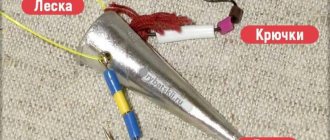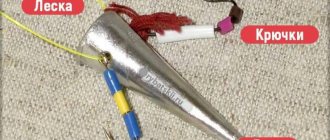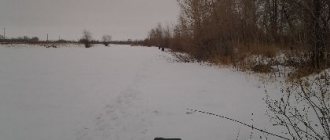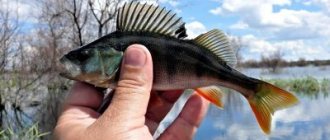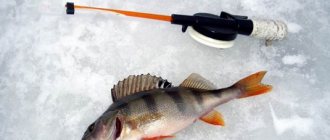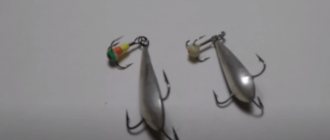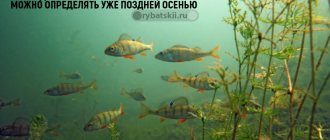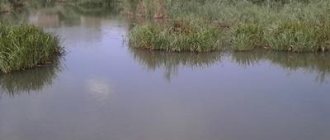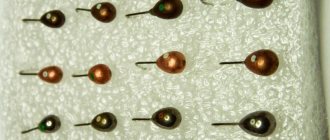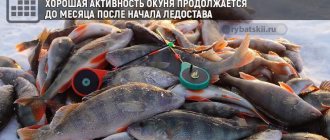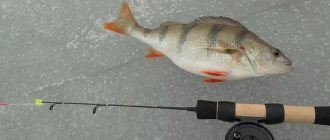Balda device
The balda is a simple equipment that includes such elements as:
- sinker;
- two hooks;
- a piece of monofilament;
- additional accessories for decoration.
The sinker is made of lead, brass or tungsten alloy. A mandatory requirement for this element of the bulldozer is the presence of a through hole in the upper (narrow) part of the body. The shape of the sinker can be cylindrical, teardrop-shaped, conical, etc.
Hooks with eyes are selected in the range of No. 8-10 with a long shank. They are decorated with artificial bloodworms, multi-colored beads, waterproof paint, thread or a fly.
A piece of monofilament fishing line 0.16-0.18 mm thick will help you make a single unit out of hooks and sinkers. Important: the breaking force of the fishing line should be less than that of the base.
Selection of the bulldozer
When going to a specialized store to buy a bulldozer, you need to focus on a number of characteristics.
After selecting all the components, you can safely go fishing for perch in winter. The color of the weight should be brown or black. In some cases, dark green color is allowed. The lower area is painted red. But the paint on lead weights hardly sticks and peels off after a while. That's why you often have to paint it a different tone. The shape of the products may vary. Among the fishermen who make the bulldozer, there are their own preferences. Hooks and weights are made of tungsten, copper, and lead. Fishermen change the shape of the bulldozer by adding a rattle to it.
You can use another form. Take a weight with a through hole, which is arranged over the entire area of the bait. Pass a fishing line with a ball through it. In fact, it turns out to be a bell. It is this kind of bait that leads to an increase in the frequency of bites.
The weight of the bait is selected depending on the depth of the reservoir. As mentioned above, it is better if it weighs 10 g. Its dimensions should be approximately 5 cm. Hooks should be selected in the classic version with number 15.
Equipment assembly
Some anglers who purchased the bait in the store are disappointed with the poor performance of the bait. Therefore, many craftsmen make equipment themselves. Even a beginner can handle this work.
First, take a fishing line and pass it through the eye of one of the hooks. The line is then passed through the hole of the sinker so that it only contacts the shank of the hook.
Next, the second hook is mounted, its tip should be located in the opposite direction from the sinker. All that remains is to make a loop, which when folded is 5-7 cm, and tie a knot. After this, you can decorate the hooks and attach the equipment to the fishing rod.
How to make such a catchy tackle (two types), as in the photo above, read in the corresponding article on our website.
Features of fishing with a fishing rod
The first feature is not unexpected. The bait called “fishing stick”, like other reelless jigs, is used to catch the most active fish at the moment.
Second feature. Often the size of the fish caught does not depend on the size of the bait. With great success, large fish are caught using a fishing rod with a small sinker. And vice versa.
But it is better to select the numbers of a pair of hooks for a reelless bait in accordance with the size of the fish that are most often caught in the reservoir.
Third feature. During fishing, the fishing rod creates quite noticeable low-frequency waves, which attracts nearby fish to the fishing spot.
Therefore, if there are no bites, it makes sense to check for the presence of fish in the fishing area with a fishing rod with a hook or a jig equipped with a natural bait. If even after this there is no bite, then, most likely, we dip our gear in an unstocked area of the reservoir.
Fourth feature. If there are no problems with catching fish with a natural bait, then perhaps to intensify the bite you should simply replace the bait with a fishing rod of a different weight, size, color or shape. Or you should slightly change the tactics of playing the bait. Perhaps changing the color of the cambrics on the “legs” of the bulldozer will improve the prospects for fishing.
But in any case, thanks to its “visibility” when creating low-frequency oscillations, it should gather a flock of cold-blooded animals under the hole (if there is one nearby).
Try it sometime when there are no bites, pull out the bait, and immediately lower a vertical spoon into the hole on a lure fishing rod. There were cases when quite good humpback whales immediately grabbed her. And you start catching perch with a spinner so that you have no time to remember about the bait.
Fishing rod for ice fishing
Winter fishing for perch on baldu is more popular among anglers. Thanks to reliable ice, you can reach any promising point in the reservoir.
You can make a fishing rod with your own hands, but the cost of this element of winter gear is so low that it is hardly worth reinventing the wheel. The length of the rod should be about 0.3-0.5 m, the blank should have sufficient rigidity. It is better to equip the tackle with a small reel to make it easier to adjust the fishing rod for different fishing depths.
The length of the monofilament ranges from 20 to 30 m, and the thickness of the nylon thread should not exceed 0.20-0.22 mm. A mandatory element of a winter fishing rod is a nod. It is selected according to the weight of the bulldozer. If, after assembling all the gear, the nod bends, but does not stretch into a straight vertical line, then the combination is chosen correctly.
How to catch perch on a bulldozer
In skillful hands, the Balda is one of the best baits for catching perch.
One of the most promising baits for catching perch is the Balda. The bullda came to the European part of the country from the Far East. Local fishermen there have been using it for a long time and successfully. The bulldozer works most successfully during the first ice season. This bait also shows good results during a period so unloved by fishermen as the wilderness. It happens that in the dead of winter there is active fishing for perch on the bald. This happens infrequently, but at such moments there is practically no time to change bait and lower the bait to great depths. And such a mothless thing like a fool helps out a lot.
Experts in catching perch from ice advise always having this bait on hand. The balda has hooks on which there is an artificial nozzle. This bait is also quite massive and often it can help out a fisherman during periods of weak or no bite.
The bulldozer consists of three parts. The main part is the body of the bait, which consists of a loop and two hooks. Colored beads or cambrics can be attached to the hooks. The sizes of both may be different.
Loading is another component of the rewinder. This element requires close attention from the angler. If the weight is not centered correctly, then the correct game will not work, and this may alert the perch.
The weight is usually made of lead. Lead is a universal metal in fishing due to its availability and low price. It is from this that the cheapest baits of various shapes and sizes are made. Lures are often made from tungsten. It costs more than lead, but all baits made from this metal are smaller in size than lead ones, but their weight will be greater. Most anglers prefer to catch perch in winter on a tungsten rod.
Tackle for fishing on the bullhead includes such important components as a fishing rod and a nod. In this case, any reel designed for ice fishing is suitable. It is better if the reel is more voluminous, because the bulldozer, in general, is a search bait. This means that the fisherman must move mobile over fairly large areas in search of active perch.
Successful perch fishing largely depends on the nod, which means that this element of the tackle must have a good balance relative to the jig. Fishing on a bulldozer also has characteristic features of the game. First, the boom is lowered to the bottom, and then raised a little up, and the bait is lightly hit on the bottom, then a pause lasting from 3 to 5 seconds is maintained.
If a perch is found in the water column, it must be lifted along the water horizons, making short strokes with the fishing rod. In this situation, striped bites can occur either during bait stops or at the time of retrieving.
Some fishermen use a bait in the form of bloodworms and, less often, maggots when fishing for bullheads. However, in this situation, the angler must constantly monitor the balance of the bait. The fact is that if one end is overloaded, it is impossible to achieve correct play with the bait. In this case, the perch will be wary and will not dare to take such bait.
Perch bites in different ways. The bait may sag or make sudden stops. In this case, even a hint of a bite should cause the angler to react to hooking. If the bite occurs while idle, there is no need to suddenly lower the rod to the bottom and resume wiring. The bait should be lowered to the bottom very slowly and in a wave-like manner, at the same time making subtle rocking motions.
Successful fishing on the Balda will require the fisherman to always have several options for these baits with him. It often happens that, in addition to perch, a large predator can also bite on the bulldozer. Large pike perch or pike often simply tear off such bait and calmly go with it to their hiding places.
Catching striped fish on a bulldozer evokes a feeling of excitement; it is very interesting, as it has various secrets and a wide range of possibilities. Depending on the body of water, different baits can be used, and all the information about the bait that is present in the article is only a small part that describes the range of possibilities of such a bait.
However, the longer the angler uses this bait, the better he will learn its secrets and capabilities. This will work out if fishing with balda occurs regularly, and the skills are constantly honed. Catching perch with this baitless bait from the ice opens up broad prospects and gives significant chances for successful fishing.
Baldu fishing technique
To interest even an active perch, you need to know the basic rules of playing with a bully. And they are quite simple.
First, the reel brake is released and the line is released until the rig sinks to the bottom. After this, the reel is moved to the working position, the fishing line is tensioned.
The first movement when fishing with a bulldozer will be to lift the equipment 3-5 cm from the bottom surface. After this, the rod sharply lowers to its original position. 2-3 postings are made at once. At this moment, the bulldozer raises turbidity in the bottom layer, which will attract the attention of the fish. After the “prelude” the game looks like this.
A short but sharp swing of 5-10 cm is made, after which the rod immediately lowers down. The body of the bulldozer should stop a centimeter from the bottom surface.
The pause is 3-5 s. At this moment, you need to watch the nod or tip of the rod. Underwater, at this time, the hooks smoothly descend along the fishing line. They are attacked by perch. 2-3 wirings are made at one point. If there is no bite, you should raise the equipment by about 20 cm.
Contrast, color of nozzles
Some fishermen claim that the hooks of the bullhead in movement resemble the “legs” of some kind of underwater bug or mollusk.
But the hooks that imitate the limbs of this bug are often equipped with contrasting attachments in quite bright colors.
Such unmasking is generally not characteristic of the small inhabitants of Russian reservoirs, although it is the movable hooks with artificial baits that attract the attention of the fish to its individual.
Some fishermen do not equip the hooks with attachments when making the bait, but simply select the color of the hooks when assembling the bait.
Some fishermen catch fish on the bait by equipping the bait with bare hooks, painting their shanks in different colors.
But the majority of fishing enthusiasts equip the balda with hooks with cambric baits of different colors, rightly believing that contrastingly alternating sections of wire insulation will be better visible to the fish when fishing in muddy water.
The same attachments also regulate the speed of lowering the hooks onto the body of the bait, as mentioned above in the text. Light cambrics increase the volume of the hooks, which allows them to fall onto the body of the bait with less speed after retrieving the bait.
Baits in the form of caddisfly and bloodworms on bulldozer hooks
Sometimes a combination of contrastingly colored beads on a hook in the form of a bloodworm or caddisfly when fishing on a fish slightly above the bottom can bring a considerable catch of completely different fish.
In order to depict the likeness of a bloodworm on bulldozer hooks with artificial baits, the first bead from the hook ring should be black. Next, depending on the length of the hook shank, 4-6 beads of contrasting red color are placed.
To depict a resemblance to a caddisfly, you should place a nozzle made of black or brown beads near the ring of the hook. The rest of the garland of beads on the hook should be a marsh color (dull green).
Nozzles for fishing with a cannon at depth
I will express one more opinion about the color of the baits on the hooks. I don’t think that their color plays any decisive role in activating the fish’s bite.
Still, here we are talking about the tactics of catching fish from the bottom of a reservoir, where at a depth of three meters there can be deep darkness, if only because of the silt raised by the fish during the feeding process.
And fish bites more often occur after the hooks of the bulldozer manage to land on the body of the bait, that is, in fact, in complete turbidity. Therefore, the fish bites, reacting to weak fluctuations in the water created by the hooks, and, to some extent, seeing the alternation of bait elements that are very contrasting in color.
It is better to place baits of contrasting bright colors on bulldozer hooks when fishing at a decent depth in heavily silted reservoirs, using one or another fishing tactics.
Where can you fish?
Balda is a universal bait that can be used both for fishing in still water and on rivers. You just need to choose the appropriate weight of the equipment. It is clear that on shallows in lakes a light sinker is required, and when deep or river fishing it is necessary to equip the fishing rod with heavy baits.
In stagnant bodies of water, you should look for perch at differences in depth, at the entrances and exits of holes. Fishing in snags should be avoided, since the equipment at the moment of falling is capable of deviating from the vertical fall. Therefore, you can lose your entire arsenal of equipment. On rivers, promising points will be coastal pools, areas with reverse flows, entrances to oxbow lakes and bays.
Bald fishing is especially effective when the perch are concentrated in large schools. Then the bites follow one after another, and the bulldozer often comes across two hungry predators. This fishing method is characterized by mobility and sportiness. Even if you don't catch many fish, the health benefits from such fishing will be maximum.
Sergey Shchetko - Specially for the site Fishing: homemade products Belarus, Stolbtsy
- Autumn fishing with bombard
- Chub fishing in autumn
Specifics of fishing
The process of this fishing is quite simple. In the classic version, the tackle is lowered to the very bottom of the reservoir and with a sharp movement rises 15–20 cm. After a few seconds, the raised bait falls to the bottom again. As a result, a small cloud of turbidity rises, which attracts the predator. Seeing a bright moving object in it, the perch thinks that it has found its natural prey and falls for one of the hooks.
The specifics of fishing vary depending on the reservoir, depth, time of year and the personal experience of the fisherman. Over time, each fisherman begins to feel his game, easily varying both the number and speed of lifts, and the time the tackle is in the raised state.
Features of ice fishing for perch on the Baldu
Features of catching perch in winter
Despite the versatility of the bait, the best time to use it is still winter. In cold, clear water, the tackle and the silt raised by it attract perch much more effectively.
However, winter fishing with this gear has a number of subtleties that are sometimes unknown to novice fishermen:
- Since competent ice fishing involves constant play with bait, the fisherman may be required to remain in one position in the cold for a long time. Therefore, you should take care of warm clothes, shoes and gloves in advance (it is advisable to have spare ones). Unfortunately, this obvious rule is neglected by many beginners.
- Perches travel in schools. Arriving at a frozen pond, the fisherman has no idea where exactly and at what moment a group of these predators will pass. Therefore, it is advisable to immediately drill several holes located at a distance of 3–4 meters from each other.
- At the initial stage, fishing is a kind of reconnaissance, the purpose of which is to find a cluster of perches. It is better to start the game from the hole closest to the shore and gradually change the location. At this stage, it is advisable to stay at each ice hole for no more than 10 minutes.
- As soon as active bites begin, the main thing is to immediately throw the tackle into the water again, since the flock may leave.
- This type of fishing is an alternation of long periods of waiting and bright moments when bites follow one after another. Therefore, you need to be prepared to spend a lot of time and effort searching for a pack of predators.
